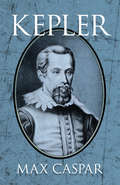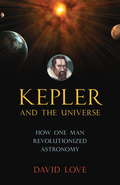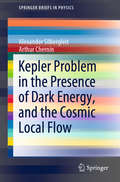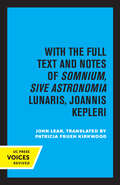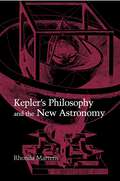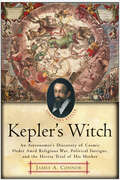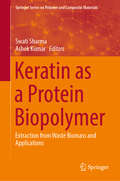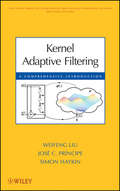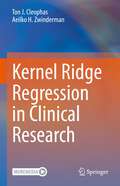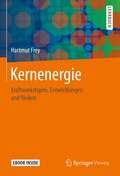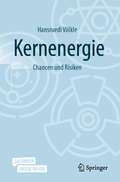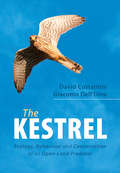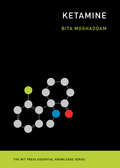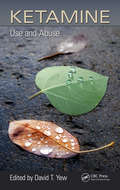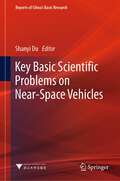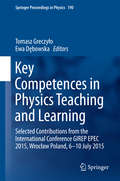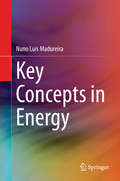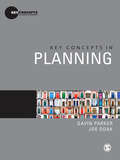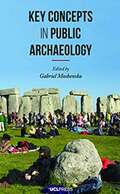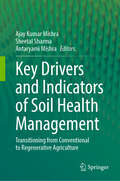- Table View
- List View
Kenzan Method for Scaffold-Free Biofabrication
by Koichi NakayamaThis is the first book about the “Kenzan” method for scaffold-free biofabrication, which does not rely on biomaterials as scaffolds to ensure correct multicellular spheroid positioning for building three dimensional construct only made from cells. The book explains the basic principles and concepts of the microneedle-based (“Kenzan”) method of building surgically-implantable tissue constructs using robotic cell spheroid-based three-dimensional bioprinting, a novel technology that opens up unique opportunities for the bioengineering of tissues and organs.First book on the novel Kenzan method of tissue engineering;Explains basic concepts and applications for organ regeneration modeling;Introduces a unique robotic system for scaffold-free cell construction.
Kepler (Dover Books On Astronomy Ser.)
by Max CasparA towering figure in intellectual history and one of the fathers of modern astronomy, the great mathematician Johannes Kepler (1571–1630) is best known for his discovery of the three laws of planetary motion, which paved the way for a dynamic explanation of the heavenly phenomena. At a time when the Ptolemaic view still prevailed in official circles, Kepler undertook to prove the truth of the Copernican world view and through exceptional perseverance and force of intellect achieved that goal. His epochal intellectual feats are completely and thoroughly described in this splendid work, considered the definitive biography of Kepler. Drawing on a wealth of primary sources, the author presents a fascinating and erudite picture of Kepler's scientific accomplishments, his public life (work with Tycho Brahe, the Danish astronomer; mathematical appointments at Graz, Prague, and Linz; pioneering work with calculus and optics, and more) and his personal life: childhood and youth, financial situation, his mother's trial as a witch, his own lifelong fear of religious persecution, his difficulties in choosing one of eleven possible young women as his second wife, and more, through his last years in Ulm and death in Regensburg.Until his death in 1956, Professor Max Caspar was the world's foremost Kepler scholar. He had spent over two-thirds of his life assembling, cataloging, describing, analyzing, and editing Kepler's works. To this biography he brought tremendous learning and passionate enthusiasm for his subject, creating an unsurpassed resource on the life and work of one of history's greatest scientific minds. Originally published in German and superbly translated into English by C. Doris Hellman, Kepler will fascinate scholars and general readers alike.
Kepler and the Universe
by David K. LoveA contemporary of Galileo and a forerunner of Isaac Newton, Johannes Kepler (1571-1630) was a pioneering German scientist and a pivotal figure in the history of astronomy. This colorful, well-researched biography brings the man and his scientific discoveries to life, showing how his contributions were every bit as important as those of Copernicus, Galileo, and Newton. It was Kepler who first advocated the completely new concept of a physical force emanating from the sun that controls the motion of the planets--today we call this gravity and take it for granted. He also established that the orbits of the planets were elliptical in shape and not circular. And his three laws of planetary motion are still used by contemporary astronomers and space scientists. The author focuses not just on these and other momentous breakthroughs but also on Kepler's arduous life, punctuated by frequent tragedy and hardships. His first wife died young, and eight of the twelve children he fathered succumbed to disease in infancy or childhood. He was frequently caught up in the religious persecutions of the day. His mother narrowly escaped death when she was accused of being a witch.Intermingling historical and personal details of Kepler's life with lucid explanations of his scientific research, this book presents a sympathetic portrait of the man and underscores the critical importance of Kepler's discoveries in the history of astronomy.From the Hardcover edition.
Kepler Problem in the Presence of Dark Energy, and the Cosmic Local Flow (SpringerBriefs in Physics)
by Alexander Silbergleit Arthur CherninThis book derives and analyzes all solutions to the Kepler problem with dark energy (DE), presenting significant results such as: (a) all radial infinite motions obey Hubble’s law at large times; (b) all orbital infinite motions are asymptotically radial and obey Hubble’s law; (c) infinite orbital motions strongly dominate the finite ones. This clearly shows the effect of repulsive DE: In the classical Kepler problem, all orbital motions are finite for negative energies and infinite in the opposite case. Another DE effect is spatial localization of bounded orbits: mostly, they are within the equilibrium sphere, where the attractive Newtonian force outbalances the repulsive force of DE. This problem is of particular current interest due to recent studies of the local flows of galaxies showing domination of DE in their dynamics; the book discusses this observation in detail.
Kepler's Dream: With the Full Text and Notes of Somnium, Sive Astronomia Lunaris, Joannis Kepleri
by John LearThis title is part of UC Press's Voices Revived program, which commemorates University of California Press’s mission to seek out and cultivate the brightest minds and give them voice, reach, and impact. Drawing on a backlist dating to 1893, Voices Revived makes high-quality, peer-reviewed scholarship accessible once again using print-on-demand technology. This title was originally published in 1965.
Kepler's Philosophy and the New Astronomy
by Rhonda MartensJohannes Kepler contributed importantly to every field he addressed. He changed the face of astronomy by abandoning principles that had been in place for two millennia, made important discoveries in optics and mathematics, and was an uncommonly good philosopher. Generally, however, Kepler's philosophical ideas have been dismissed as irrelevant and even detrimental to his legacy of scientific accomplishment. Here, Rhonda Martens offers the first extended study of Kepler's philosophical views and shows how those views helped him construct and justify the new astronomy. Martens notes that since Kepler became a Copernican before any empirical evidence supported Copernicus over the entrenched Ptolemaic system, his initial reasons for preferring Copernicanism were not telescope observations but rather methodological and metaphysical commitments. Further, she shows that Kepler's metaphysics supported the strikingly modern view of astronomical method that led him to discover the three laws of planetary motion and to wed physics and astronomy--a key development in the scientific revolution. By tracing the evolution of Kepler's thought in his astronomical, metaphysical, and epistemological works, Martens explores the complex interplay between changes in his philosophical views and the status of his astronomical discoveries. She shows how Kepler's philosophy paved the way for the discovery of elliptical orbits and provided a defense of physical astronomy's methodological soundness. In doing so, Martens demonstrates how an empirical discipline was inspired and profoundly shaped by philosophical assumptions.
Kepler's Witch: An Astronomer's Discovery of Cosmic Order Amid Religious War, Political Intrigue, and the Heresy Trial of His Mother
by James A. ConnorSet against the backdrop of the witchcraft trial of his mother, this lively biography of Johannes Kepler – 'the Protestant Galileo' and 16th century mathematician and astronomer – reveals the surprisingly spiritual nature of the quest of early modern science. In the style of Dava Sobel's Galileo's Daughter, Connor's book brings to life the tidal forces of Reformation, Counter–Reformation, and social upheaval. Johannes Kepler, who discovered the three basic laws of planetary motion, was persecuted for his support of the Copernican system. After a neighbour accused his mother of witchcraft, Kepler quit his post as the Imperial mathematician to defend her. James Connor tells Kepler's story as a pilgrimage, a spiritual journey into the modern world through war and disease and terrible injustice, a journey reflected in the evolution of Kepler's geometrical model of the cosmos into a musical model, harmony into greater harmony. The leitmotif of the witch trial adds a third dimension to Kepler's biography by setting his personal life within his own times. The acts of this trial, including Kepler's letters and the accounts of the witnesses, although published in their original German dialects, had never before been translated into English. Echoing some of Dava Sobel's work for Galileo's Daughter, Connor has translated the witch trial documents into English. With a great respect for the history of these times and the life of this man, Connor's accessible story illuminates the life of Kepler, the man of science, but also Kepler, a man of uncommon faith and vision.
Keramik: Wie ein alter Werkstoff hochmodern wird (Technik im Fokus)
by Dagmar HülsenbergSeit wann kennt man Keramikerzeugnisse? Warum verhalten sich Keramikwerkstoffe im Vergleich zu anderen Werkstoffen völlig anders? Was macht sie so besonders? Wie stellt man sie her? Welche modernen Anwendungen gibt es?Die Autorin gibt Antworten auf diese und weitere Fragen zu einem alten und doch hochmodernen Werkstoff. Sie beschreibt gut verständlich die physikalisch-chemischen Grundlagen, welche die Andersartigkeit von Keramik in Herstellung und Eigenschaften erklären. Und sie geht auf die vielfältigen Anwendungsbereiche ein, sei es in traditionellen Gebieten oder in modernen Anwendungen wie als Katalysatorträger, Dieselpartikelfilter oder in der Energiespeicherung.
Keratin as a Protein Biopolymer: Extraction from Waste Biomass and Applications (Springer Series on Polymer and Composite Materials)
by Swati Sharma Ashok KumarThis book provides information about the sources, structure, and properties of keratin as well as its applications. The extraction from different biomass sources (e.g. feathers, hairs, nails, horn, hoof, and claws) as well as the characterization methods of these extracted materials are explained. The development of bioproducts from keratins is challenging and limited since they are neither soluble in polar solvents nor in non-polar solvents. Therefore, the utilization of different microorganisms for the degradation of keratin is also discussed.The main aim of this book is to highlight the unique features of keratin and to update readers with the possible prospects to develop various value-added products from keratins. The book is highly interesting to researchers working in industry and academia on bioproducts, tissue engineering, biocomposites, biofilm, and biofibers.
Kernel Adaptive Filtering
by Weifeng Liu Simon Haykin José C. PrincipeOnline learning from a signal processing perspectiveThere is increased interest in kernel learning algorithms in neural networks and a growing need for nonlinear adaptive algorithms in advanced signal processing, communications, and controls. Kernel Adaptive Filtering is the first book to present a comprehensive, unifying introduction to online learning algorithms in reproducing kernel Hilbert spaces. Based on research being conducted in the Computational Neuro-Engineering Laboratory at the University of Florida and in the Cognitive Systems Laboratory at McMaster University, Ontario, Canada, this unique resource elevates the adaptive filtering theory to a new level, presenting a new design methodology of nonlinear adaptive filters.Covers the kernel least mean squares algorithm, kernel affine projection algorithms, the kernel recursive least squares algorithm, the theory of Gaussian process regression, and the extended kernel recursive least squares algorithmPresents a powerful model-selection method called maximum marginal likelihoodAddresses the principal bottleneck of kernel adaptive filters--their growing structureFeatures twelve computer-oriented experiments to reinforce the concepts, with MATLAB codes downloadable from the authors' Web siteConcludes each chapter with a summary of the state of the art and potential future directions for original researchKernel Adaptive Filtering is ideal for engineers, computer scientists, and graduate students interested in nonlinear adaptive systems for online applications (applications where the data stream arrives one sample at a time and incremental optimal solutions are desirable). It is also a useful guide for those who look for nonlinear adaptive filtering methodologies to solve practical problems.
Kernel Ridge Regression in Clinical Research
by Ton J. Cleophas Aeilko H. ZwindermanIBM (international business machines) has published in its SPSS statistical software 2022 update a very important novel regression method entitled Kernel Ridge Regression (KRR). It is an extension of the currently available regression methods, and is suitable for pattern recognition in high dimensional data, particularly, when alternative methods fail. Its theoretical advantages are plenty and include thekernel trick for reduced arithmetic complexity,estimation of uncertainty by Gaussians unlike histograms,corrected data-overfit by ridge regularization,availability of 8 alternative kernel density models for datafit.A very exciting and wide array of preliminary KRR research has already been published by major disciplines (like studies in quantum mechanics and nuclear physics, studies of molecular affinity / dynamics, atomisation energy studies, but also forecasting economics studies, IoT (internet of things) studies for e-networks, plant stress response studies, big data streaming studies, etc). In contrast, it is virtually unused in clinical research. This edition is the first textbook and tutorial of kernel ridge regressions for medical and healthcare students as well as recollection / update bench, and help desk for professionals. Each chapter can be studied as a standalone, and, using, real as well as hypothesized data, it tests the performance of the novel methodology against traditional regression analyses. Step by step analyses of over 20 data files stored at Supplementary Files at Springer Interlink are included for self-assessment. We should add that the authors are well qualified in their field. Professor Zwinderman is past-president of the International Society of Biostatistics (2012-2015) and Professor Cleophas is past-president of the American College of Angiology (2000-2002). From their expertise they should be able to make adequate selections of modern KRR methods for the benefit of physicians, students, and investigators. The authors have been working and publishing together for 24 years and their research can be characterized as a continued effort to demonstrate that clinical data analysis is not mathematics but rather a discipline at the interface of biology and mathematics.
Kernenergie: Kraftwerkstypen, Entwicklungen und Risiken
by Hartmut FreyDie Nachfrage nach fossilen Brennstoffen steigt stetig an. Zugleich produzieren sie in der Stromgestehung aufgrund der Oxidationsprozesse Kohlendioxid, das dann in die Atmosphäre entweicht und dort als Treibhausgas die Wärmestrahlung adsorbiert und remittiert. Seit geraumer Zeit werden in einigen Ländern neue Kernkraftwerke gebaut. Die weltweite Akzeptanz der Stromerzeugung durch Kernenergie hat durch die Katastrophen von Tschernobyl und Fukushima gelitten, wobei Tschernobyl auf menschliches Versagen beruhte, während die Reaktorblöcke in Fukushima optimal auf Erdbeben ausgelegt waren, nicht aber auf den eines Tsunami. Das Buch fasst den Stand der Technik zusammen, berücksichtigt Beteiligungsprozesse der Öffentlichkeit sowie absehbare Entwicklungen in den Lebensgewohnheiten und politische Vorgaben.
Kernenergie
by Julia Neles Christoph PistnerKnapp und klar arbeitet der Autor die Grundlagen zum Verständnis der Kernenergie heraus und ermöglicht Lesern damit einen leichten Einstieg ins Thema. Dabei vermittelt er nicht nur die technisch-wissenschaftlichen Grundlagen in allgemein verständlicher und umfassender Weise, sondern befasst sich auch mit den gesellschaftspolitischen Fragen der Sicherheit, der Entsorgung und der nuklearen Abrüstung. Der Band bietet die Möglichkeit, die aktuellen Entwicklungen nach der Reaktorkatastrophe in Fukushima einzuordnen und zu reflektieren.
Kernenergie: Chancen und Risiken
by Hansruedi VölkleDieses Buch beschäftigt sich mit der Frage, ob beim Streit um die Kernenergie der rechtzeitige Ausstieg aus fossilen Brenn- und Treibstoffen verpasst werden könnte und ob angesichts des Klimawandels und der Energiekrise die Rolle der Kernenergie neu überdacht werden sollte.Das Buch beginnt bei der Entdeckung der Kernspaltung und den Kernwaffenversuchen und diskutiert die Folgen der Reaktorkatastrophen von Tschernobyl und Fukushima. Anschließend erhält der Leser einen Überblick über die Herausforderungen, die sich bei der Nutzung der Kernenergie stellen. Weitere Kapitel behandeln die Wirkung von Strahlung und die damit verbundenen Risiken und stellt diese in den Kontext der Gefahren des täglichen Lebens. Im Anschluss steht die Frage im Fokus, wie die nukleare Sicherheit und der Notfallschutz verbessert werden können. Der Autor reflektiert, welche Herausforderungen eine nachhaltige und CO2-freie Energiewirtschaft bedeuten und welche Energiequellen, zumindest in einer Übergangsphase, eine Rolle spielen könnten. Der Autor diskutiert Vor- und Nachteile eines Kernkraftausstiegs angesichts des Klimawandels und im Rahmen einer Energiestrategie, bei der in Zukunft der Strom zum Hauptenergieträger wird. Der Autor Hansruedi Völkle studierte Physik, promovierte 1980 zum Thema Kernphysik und Strahlenschutz. 2001 wurde er an der Universität Fribourg zum Titularprofessor ernannt. Beim Schweizer Bundesamt für Gesundheit war er viele Jahre im Strahlenschutz und bei der Überwachung der Umweltradioaktivität tätig. An der Universität Fribourg leitete er das Studienprogramm in Umweltwissenschaften. Fast 20 Jahre diente er der Deutsch-Schweizerischen Kommission für die Sicherheit kerntechnischer Einrichtungen als Experte im Strahlenschutz.
The Kestrel: Ecology, Behaviour and Conservation of an Open-Land Predator
by David Costantini Giacomo Dell'OmoWidespread across open lands and cities of Europe, Africa, and Asia, the common kestrel (Falco tinnunculus) is one of the most abundant and studied birds of prey. This book brings together and synthesises the results of research on kestrels for professional ornithologists and scientists that seek to consolidate a vast body of literature. It is also a reference for those readers who may not have the depth of scientific knowledge to navigate new fields of scientific enquiry. It examines many aspects of the species' biology, from the reproductive strategies to the behavioural and demographic adaptations to changes of environmental conditions. It also discusses the roles of physiology and immunology in mediating the adaptability of kestrels to the ongoing environmental changes with a particular focus on contaminants. This volume presents new and exciting avenues of research on the ecology and behaviour of the common kestrel.
Ketamine: From Abused Drug to Rapid-Acting Antidepressant
by Kenji Hashimoto Soichiro Ide Kazutaka IkedaThis book presents the latest data from basic research and clinical trials supporting the effectiveness of ketamine as a treatment for depression, bipolar disorder, and suicidal behavior, setting these positive findings within the context of the serious problem of ketamine abuse. The first part of the book focuses on the evidence regarding ketamine abuse, with specific reference to Asian countries, and discusses countermeasures and complication management. It then addresses the mechanisms underlying the antidepressant and side effects of ketamine, which have remained elusive, describing and discussing important new research findings. Further, it explains insights gained from whole brain imaging in rodents and from behavioral pharmacology, and presents evidence regarding the role of gut microbiota, the NMDA receptor GluN2D subunit, and the lateral habenula in the actions of ketamine. These advances form the basis for the safer use of ketamine in patients with treatment-resistant depression and are expected to lead to the development of new antidepressants.
Ketamine (The MIT Press Essential Knowledge series)
by Bita MoghaddamThe emergence of ketamine--previously known as a combat anesthetic and club drug--as a treatment for depression.Ketamine, approved in 2019 by the Food and Drug Administration for the treatment of depression, has been touted by scientists and media reports as something approaching a miracle cure. This volume in the MIT Press Essential Knowledge series chronicles the ascent of a drug that has been around for fifty years--in previous incarnations, a Vietnam-era combat anesthetic and a popular club drug--that has now been reinvented as a treatment for depression. Bita Moghaddam, a leading researcher in neuropharmacology, explains the scientific history and the biology of ketamine, its clinical use, and its recently discovered antidepressant effects, for the nonspecialist reader.
Ketamine: Use and Abuse
by David T. YewIncreasing use of ketamine as a recreational drug in Asia, Europe, and America is a great burden on society at large, leading to aspirational strain, unemployment, and crime. These societal effects have led to growing interest among researchers and clinicians in ketamine's effects on various systems of the body. Ketamine: Use and Abuse reviews the
Key Basic Scientific Problems on Near-Space Vehicles (Reports of China’s Basic Research)
by Shanyi DuThis book mainly introduces the research overview, research results, and follow-up prospects of “Key Basic Scientific Problems on Near-Space Vehicles”, a major research plan of National Natural Science Foundation of China (hereinafter referred to as the Plan). The Plan is the first systematic basic hypersonic research program in China. From its inception in 2007 to its successful completion in 2016, the Plan lasted nine years, funded a total of 173 projects, and the funding totaled 190 million yuan. From the perspective of major national needs and scientific discipline development, the book focuses on four key scientific issues: aerodynamics in a near-space flight environment; advanced propulsion theories and methods; ultralight materials/structures, thermal environment prediction and thermal protection; and intelligent autonomous control theories and methods for hypersonic vehicles. The book also demonstrates China’s systematic and innovative achievements in interdisciplinary theories and methods and innovative techniques, paving the way for a distinctively Chinese basic research framework and further breakthroughs of near-space hypersonic vehicles.
Key Competences in Physics Teaching and Learning
by Tomasz Greczyło Ewa DębowskaThis book presents a selection of the best contributions to GIREP EPEC 2015, the Conference of the International Research Group on Physics Teaching (GIREP) and the European Physical Society's Physics Education Division (EPS PED). It introduces readers interested in the field to the problem of identifying strategies and tools to improve physics teaching and learning so as to convey Key Competences and help students acquire them. The main topic of the conference was Key Competences (KC) in physics teaching and learning in the form of knowledge, skills and attitudes that are fundamental for every member of society. Given the role of physics as a field strongly connected not only to digital competence but also to several other Key Competences, this conference provided a forum for in-depth discussions of related issues.
Key Concepts in Energy
by Nuno Luis MadureiraOrganized around eight fundamental ideas, Key concepts in energy history explores the discoveries, technologies and new paradigms in the field of energy, and how they have changed the course of history Complex technical concepts such as the "rebound effect", "technological hybridization", "marginal cost pricing" are explained in clear terms and a balanced and concise account of t energy sources in the XIX and XX century such as wood, coal, oil, hydroelectricity and nuclear energy is provided. Key concepts in energy considers the process of energy-substitutions and analyzes it as a process of complementary usages, hybridization and technological mixes. The ex-post view tends to focus on replacement from among alternative energy-technologies and is basically innovation-centric. This means that little attention has been given to factors such as the windows of opportunities created by governments, inventors and entrepreneurs. This book highlights how key energy concepts surfaced, tracing their evolution throughout history It encompasses four economic concepts (rebound effect, energy intensity, marginal cost pricing and levelized cost accounting) and four technological-engineering concepts (primary/final energy, technological hybridization, last gasp and probable oil reserves) The main benefit from reading the book is a cross disciplinary overview of energy fundamentals in a short and focused reading.
Key Concepts in Planning (Key Concepts in Human Geography)
by Joe Doak Gavin Parker"I have been looking for a book which does this for ages! It provides a clear explanation of the different elements and concepts which underpin how the planning system works and which are fundamental to the operation of the UK system. It also provides good guidance on further reading. A real assett to anyone wanting to understand the nature of planning in the UK" - Dr Catherine Hammond, Architecture and Planning, Sheffield Hallam University Key Concepts in Planning forms part of an innovative set of companion texts for the human geography sub-disciplines. Organized around 19 short essays, the book provides a cutting edge introduction to the central concepts that define contemporary research in planning. Involving detailed and expansive discussions, the text includes: An introductory chapter providing a succinct overview of the recent developments in the field. 18 key concept entries with comprehensive explanations, definitions and evolutions of the subject. Detailed suggested further reading for each concept discussed. It is an ideal companion text for upper-level undergraduate and postgraduate students in planning, and covers the expected staples of the discipline in an accessible style.
Key Concepts in Public Archaeology
by Gabriel MoshenskaThis book provides a broad overview of the key concepts in public archaeology, a research field that examines the relationship between archaeology and the public, in both theoretical and practical terms. While based on the long-standing programme of undergraduate and graduate teaching in public archaeology at UCL’s renowned Institute of Archaeology, the book also takes into account the growth of scholarship from around the world and seeks to clarify what exactly ‘public archaeology’ is by promoting an inclusive, socially and politically engaged vision of the discipline. <p><p> Written for students and practitioners, the individual chapters provide textbook-level introductions to the themes, theories and controversies that connect archaeology to wider society, from the trade in illicit antiquities to the use of digital media in public engagement, and point readers to the most relevant case studies and learning resources to aid their further study. <p><p> This book was produced as part of JISC's Institution as e-Textbook Publisher project. Find out more at https://www.jisc.ac.uk/rd/projects/institution-as-e-textbook-publisher
Key Concepts in Social Gerontology (SAGE Key Concepts series)
by Sarah Hillcoat-Nalletamby Kristine J. Ajrouch Judith E. PhillipsSocial gerontology is a new and dynamic field reflecting the increasing interest in ageing across the world. This book provides a readily accessible guide to well established and contested issues, as well as new concepts emerging through cutting edge research in the discipline. The entries give concise, lucid knowledge on what constitutes the 'building blocks' of social gerontology and sets out a clear review of the core concepts, both classic and emerging, in this subject area. Each concept is explored in terms of its: * History * Application * Usefulness to theory and research * Significance in practice They go beyond simple definition of the concepts to look at how each issue has shaped the discipline of social gerontology today. This book is authored by social gerontologists from the UK and the USA. Together they present an interdisciplinary perspective and reflect a global approach to the presentation of key concepts in social gerontology. Judith Phillips is Professor of Gerontology and Social Work at Swansea University, Wales Kristine Ajrouch is Associate Professor of Sociology at Eastern Michigan University Sarah Hillcoat-Nallétamby is Senior Lecturer in Social Policy at Swansea University, Wales
Key Drivers and Indicators of Soil Health Management: Transitioning from Conventional to Regenerative Agriculture
by Ajay Kumar Mishra Sheetal Sharma Antaryami MishraThis book explores the crucial transition from conventional to regenerative agriculture practices, focusing on the key drivers and indicators of soil health management. It provides knowledge to implement sustainable agricultural systems that prioritize soil health and foster the transition toward regenerative practices. This book delves into the principles and concepts of soil health, the challenges and limitations of conventional agriculture, the assessment of soil health through various indicators, and the importance of cover crops, crop rotation, conservation tillage, nutrient management, and water conservation practices. It also addresses the role of soil biodiversity, policy frameworks, and scaling up regenerative agriculture, providing practical strategies and case studies. The target audience for this book ranges from students and researchers to policymakers and large-scale farmers. Farmers will benefit from the practical insights and strategies presented, and policymakers and agricultural organizations can gain valuable knowledge on the drivers and policy frameworks supporting sustainable agriculture and soil health management. This book explores the crucial transition from conventional to regenerative agriculture practices, focusing on the key drivers and indicators of soil health management. It provides knowledge to implement sustainable agricultural systems that prioritize soil health and foster the transition toward regenerative practices. This book delves into the principles and concepts of soil health, the challenges and limitations of conventional agriculture, the assessment of soil health through various indicators, and the importance of cover crops, crop rotation, conservation tillage, nutrient management, and water conservation practices. It also addresses the role of soil biodiversity, policy frameworks, and scaling up regenerative agriculture, providing practical strategies and case studies. The target audience for this book ranges from students and researchers to policymakers and large-scale farmers. Farmers will benefit from the practical insights and strategies presented, and policymakers and agricultural organizations can gain valuable knowledge on the drivers and policy frameworks supporting sustainable agriculture and soil health management.

